High Protein Sources for an ADHD Diet
Protein is such an important mood stabilizing, brain boosting nutrient for our ADHD Kids. In this post, I focus more heavily on many sources of protein for your ADHD kiddo that might not be as familiar to you.
Perhaps I should title this, Protein Sources for ADHD Kids who don’t really like meat or fish!
There are so many other great ways for your kiddos to meet their needs for protein. And even if they love animal protein, you may snag some new ideas to help put some cash back in your pocket.
We all know a healthy diet should be the back bone of any ADHD treatment plan. What goes into our kids’ bodies can have such a huge affect on how their brain and nervous system work and ultimately how they are able to function on a daily basis.
Buckle Up – this is a big post, so I’ve included lots of headings so you can easily find what interests you. If you need some ideas for new protein sources for an ADHD Diet, this post is for you!
**This post contains affiliate links for your convenience. As always, buy local first!**
Why ADHD Kids Need Protein
Following a diet high in protein can be very helpful in reducing the symptoms of ADHD, advises, Dr. Vince Monastra.
He reminds us that when kids eat foods containing protein their bodies can make neurotransmitters like dopamine, serotonin and GABA. These are important because they help our kids concentrate, control their moods, and help them maintain a calm, focused state.
Protein helps keep blood sugar stable and it provides important building blocks for our brains.
According to Dr. Monastra, out of the 500 kids he evaluates for ADHD every year, only about 5 percent get the recommended amount of protein.
Wow! Sounds like we all need to make sure our ADHD Kiddos are getting enough protein!
But, getting your kiddo to eat the recommended amount of protein can be another thing. ADHD Kids are often picky eaters, who love carbs and sugar.
So, I set out on the hunt for sources of protein that may not be as obvious, but are just as good (or better!) as the obvious sources of protein.
Protein and an ADHD Diet – How much?
It’s great to be aware of about how much protein your kiddo should be getting on a daily basis. Use this number to plan your meals and snacks, knowing things will fluctuate a bit.
In other words, don’t let yourself go crazy about it. Adding a big dose of stress to their diets is not good either.
According to the National Academies of Sciences, Engineering and Medicine, boys between the ages of 14 and 18 need 56 grams of protein, with girls the same age needing only 46 grams.
Kids between 4 and 9 need 19 grams, and those between 9 and 13, need 34 grams.
Read on to see what will work for you and your family!
Grass Fed Meat, Wild caught fish, Eggs
Grass fed beef and free range poultry, wild caught fish, and eggs are the obvious sources of protein that I will not cover in depth in this article.
Their reputation certainly precedes them and you probably already know they contain all the amino acids your body needs to function, plus a whole host of vitamins and minerals. They are usually high in B12, a great vitamin for increased brain function. Wild caught fish contains brain boosting Omega 3’s, as well.
And, oh the protein! 3 oz. of tuna has 20 grams of protein, 1 egg has 6 grams of protein, 4 oz. of ground beef has 16 grams, and chicken boasts 19 grams in 1/2 cup serving.
Animal protein is great for so many reasons, ……..and I hear you saying…
But MY kids won’t eat animal protein!
I get it.
I’ve got two ADHD Kiddos at home who seem to just be getting pickier as they get older.
Even though animal protein may be the easiest and most obvious protein choice to purchase, your ADHD kiddo may not be so compliant about eating it.
There are many reasons lots of ADHD kids struggle with animal protein in it’s simplest form.
- Our differently wired kids can be huge empaths and very often lean into vegetarianism from a very young age.
- Animal protein can put kids into sensory overload – the smells and textures may be difficult for kids to handle.
- High quality animal protein is expensive and can be a real budget buster and has us parents looking for different options!
I’m more interested in protein sources that can be found off the beaten path and can fit just about everyone’s budget, and can definitely serve as a compliment to animal protein, as well.
But before we move on to those other options, I do have to mention a few very important things about animal protein.
A few important considerations with animal protein:
Look out for mercury laden fish – this neurotoxin is very common in many kinds of fish and can have serious effects in children and infants. Check out the EWG’s website for brands and varieties that are better choices.
When I found out my kids tested positive for heavy metals, I had to take a second look at a lot of things, one being the brands of tuna we ate. My research brought me to Crown Prince Tuna and SafeCatch Tuna, two brands who are very serious about their customers’ health.
Purchase the highest quality meat and fish you can afford. Remember, you are what you eat, eats! Meat full of hormones and genetically modified feed should be avoided, if at all possible. Read about grass fed vs. grain fed beef, HERE.
High quality animal protein can be a huge budget buster, for sure. The majority of us are on a grocery budget that does not always allow for lots of grass fed beef and wild caught fish. That is why I’ve got some suggestions for other great sources of protein that you can eat instead of high priced meat and seafood.
Budget Tip: Imperfect Foods is a weekly delivery service we use that has a ton of high quality protein sources for a very decent price. I get my grass fed ground beef from them and the occasional chemical free bacon, as well! Use this code to get 10 bucks off your first purchase (and I’ll get 10 bucks off, too!)
Related : Staying on budget on an ADHD Diet
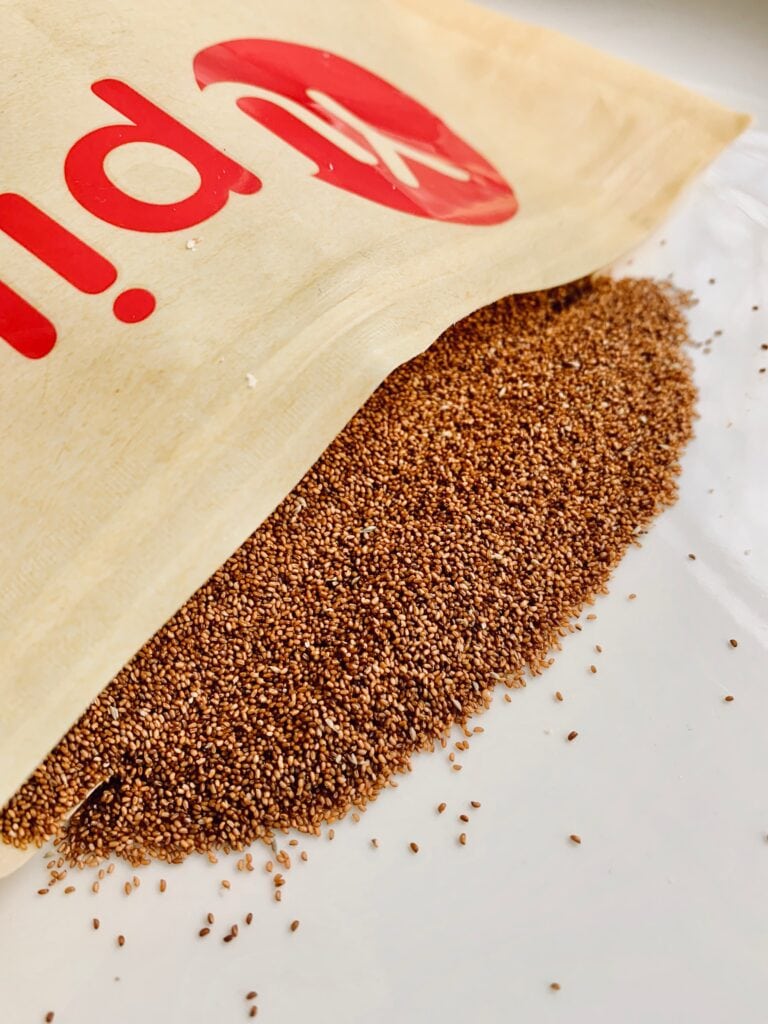
High Protein Grains
Grains are often very appealing to kids and are budget friendly. Win, Win!
There are many great high protein grain options to work into your weekly repertoire. I love to discover new gluten free grains coming onto the scene in the US, which have been used in other countries for literally thousands of years.
Teff
Teff (pictured above) is actually a seed, but acts like a grain. This fairly new to me seed, has been used for thousands of years in Africa and other parts of the world. It is actually thought to be one of the first foods domesticated by humans!
Teff contains more calcium than any other grain and is also a complete protein, which means it contains all the amino acids needed for optimal brain function. It’s also high in iron and magnesium, protein and fiber.
Just 1/4 cup of teff contains 8 grams of protein and 4 grams of fiber. The texture and flavor are subtle, meaning no surprises for picky eaters.
Teff is often ground into flour and is naturally gluten and grain free. Sounds like a perfect protein source for an ADHD Diet.
It can be cooked like a porridge (I mix it into oatmeal) or baked with like a grain.
Try these Teff recipes : This super food brownie recipe is my kids’ new favorite. Teff pancakes have a great, hearty texture. I can’t wait to try this Teff bread recipe!
Teff for breakfast, porridge style is super easy and a great vehicle for adding in other ADHD superfoods, like chia or flax seed.
Amaranth
Another ancient grain that has been around for thousands of years, Amaranth is getting press lately because it is naturally gluten free and contains a whole host of other nutrients.
Amaranth has double the fiber of whole wheat flour (about 9 grams per 1 cup cooked) and also boasts 5 grams of protein per serving. It also has more lysine– an essential amino acid-than any other grain.
Try adding amaranth in your favorite baked goods recipes to give them a boost of nutrition ! Replace a fourth to a third of your flour with it when you are doing your gluten free baking, as it can make baked good very dense.
Amaranth recipes to try: This grain can also be part of savory dishes like these amaranth veggie patties , amaranth tabouli, or this chickpea and amaranth salad.
Quinoa
Quinoa’s popularity has just exploded over the past 5 or so years and could already be a staple in your diet. If it’s not, let me tell you why it should be!
Quinoa, officially a seed, has about 8 grams of protein per cup. It is special, because it is one of the sources of plant protein that contains all 9 amino acids in one grain.
It is also high in fiber, magnesium, B vitamins, iron and zinc.
Quinoa is super versatile and can go savory or sweet. I also love quinoa because it cooks up relatively quickly on the stove and keeps well for days of leftovers.
Quinoa recipes to try: I love to make a stew like this one with beans and veggies, or whip up a simple quinoa bowl with what ever is in the fridge.
This breakfast version of cinnamon quinoa is also great!
Check out more quinoa recipes on my gluten free, dairy free dinners Pinterest Board here.
Budget Tip: We get our Organic Quinoa from Imperfect Foods
Brown Rice
Brown Rice can be a budget friendly staple and it has some really great nutritional content – yes, it has protein!
1 cup of cooked brown rice has 5 grams of protein, plus significant amounts of magnesium and B vitamins. It also has nearly 4 grams of fiber . Remember : 30 grams of fiber is a good goal for kids 4 and over.
Brown vs. White Rice – Both varieties of rice contain protein and nutrients, but the bran and germ are removed from brown rice to make it white. This also makes the rice lose fiber, antioxidants, and B vitamins. Some white rice is enriched with synthetic vitamins – but, I’d rather stick with brown rice and eat what nature provided in the first place!
A note about arsenic in rice: Arsenic can be found in all rice, even organic rice, due to the growing method and arsenic residues in the soil from man and the erosion of arsenic containing compounds. It’s best to soak your rice and then rinse it thoroughly to help get rid of some of this. Reach for organic rice, as this can be a better option.
We usually make a huge Instapot full of brown rice to eat for several days.
Grain bowls are a great ADHD Diet meal idea!!
Cook a big bunch of grain on Sunday and have several meals for the week. Your family can top grains with cooked meat or fish, roasted sweet potato, cooked veggies, nuts, seeds, hummus, beans…..get creative! We love to make a batch of tahini dressing to drizzle over our bowls.
A note about soaking grains:
Soaking any grain, before you cook it is a good idea – it’s been a practice for generations.
There are compounds in grains that make it harder for you to absorb all the mineral goodness in them.
By soaking grains in warm water overnight, you help to release the enzyme phytase, which helps unbind the minerals in the grains, making them available for you! Soaking grains also makes them much easier for you to digest.
But, if you forget to soak your grains, go ahead and cook them anyway – you’ll still reap many, many rewards from eating them!
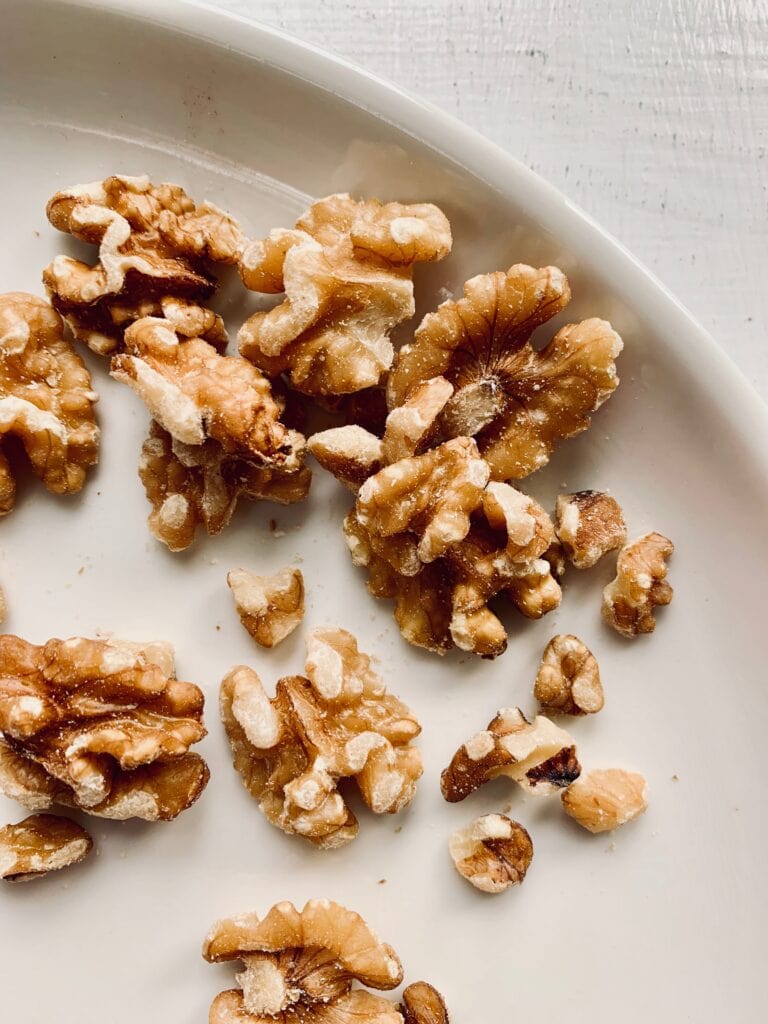
High Protein Nuts and Seeds
Nuts and seeds are some of the most protein rich foods around. They are great for snacking , come in all different forms, can fit nicely into baked goods especially when ground into flour.
There are sooo many nut and seed options, I am just going to talk about a few that really pack a nutritional punch, are high in protein and other good stuff, too. There are many, many great ones that did not make this list and in no way means they are not great to eat, also.
But, it’s always good to add variety to your diet, so try something new!
Pumpkin Seeds
Pumpkin Seeds, also know as pepitas, pack a lot of protein at 8 to 10 grams a 1/4 cup.
They are also high in magnesium, iron, vitamin K, and zinc, to name a few. Pumpkin seeds are also high in anti-oxidants which help reduce inflammation in the body.
Pumpkin seeds are also high in tryptophan – that relaxing, feel good chemical we all know to be in turkey, making these great food to reduce anxiety!
The small, mild tasting, seeds are easy to squeeze into your diet. Add them to baked goods and smoothies, eat them roasted with a bit of salt, toss on salads or into coconut yogurt.
Pistachios
Pistachios are not only high in protein, but they are also a good source of B vitamins, fiber, and magnesium, too!
A 1 oz. serving(about 50 pistachios) contains 6 grams of protein, plus a load of B vitamins, good fats, and even more gut building bacteria than almonds.
Pistachios can be on the pricier side, so look for sales or buy in bulk. Also, watch out for nuts that are heavily salted — go for the unsalted or low salt versions whenever possible.
Cracking the shells to get out the meat can be a great way for kids to slow down when they are eating, too! (The nuts in the shells are always cheaper, too.)
Try this 4 ingredient vegan pistachio ice cream as an easy way to get your kids to eat this healthful nut.
Almonds
There is so much to love about almonds!
A 1 oz. serving of almonds contains 6 grams of protein, plus relatively large amounts of manganese, magnesium, and vitamin E.
PLUS, almonds contain antioxidants which control inflammation, banish brain fog, help keep the gut healthy and boost are immunity.
Swap out peanut butter for almond butter as a super easy way to add almonds to your diet.
Almond flour is a great alternative to wheat flour and bakes up some pretty healthy cookies and bars. Try these breakfast favorites of ours – Cowboy Cookies!
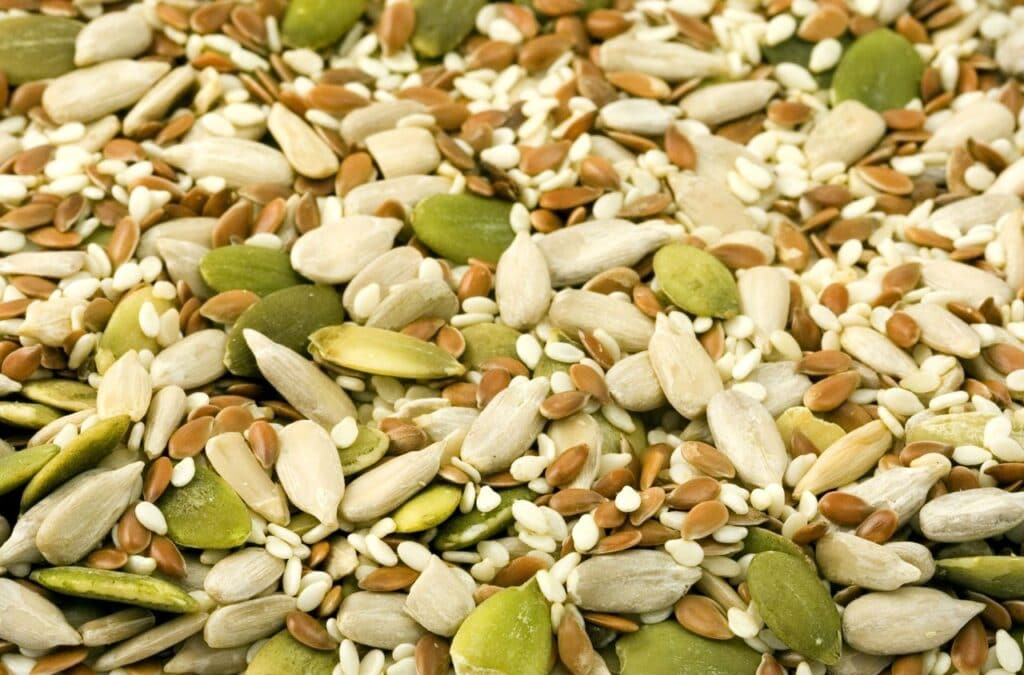
Sunflower Seeds
Sunflower seeds are a great protein alternative when kids have nut allergies or need to comply with a nut free school.
Sunflower seeds pack a protein punch, are high in the B vitamins, fiber and antioxidants as well.
A 1 oz. serving contains 5.5 grams of protein, a third of your vitamin E for the day, plus a good portion of many of the B vitamins ( Niacin, B6 and Folate). Sunflower seeds are also one of the best sources of selenium – a nutrient shown to be particularly important for the function of neurotransmitters – a big plus for ADHD kids.
We love Sunbutter as a swap for Peanut Butter (watch the sugar content) and we love to snack on lightly salted sunflower seeds. Add them to oatmeal or bake them into muffins.
This raisin and sunflower energy ball recipe is super, too!
Our favorite bars are sunflower based Macro Bars and Enjoy Life balls(cheapest at Trader Joes!)
Walnuts
Walnuts don’t always get a lot of press, but they should!
They have over 4 grams of protein per 12 walnut halves and 2 grams of fiber (about 8% of your daily need)
High is good fats, they contain the plant version of Omega-3’s, alpha-linolenic acid
Walnuts are secondary only to blackberries in the amount of anti oxidants per ounce!
I love adding walnuts to salads and pasta dishes or chopping them up for my cowboy cookies.
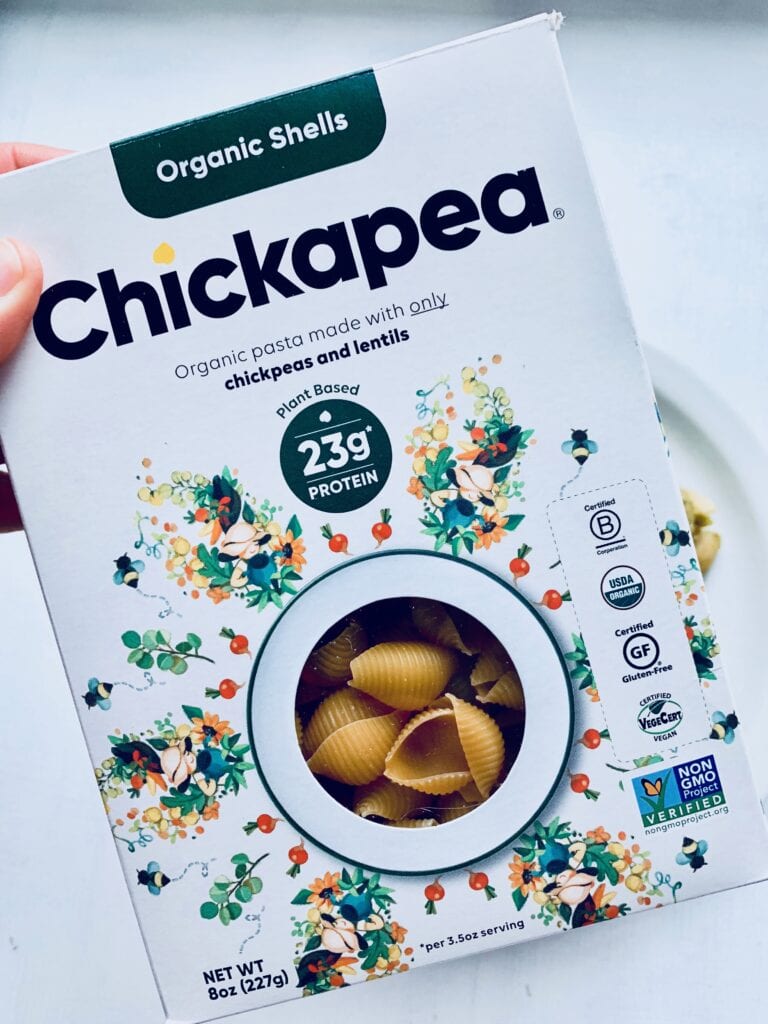
High Protein Legumes
Legumes are another budget friendly way to get protein into your kiddos. They have a mild taste and can be added to so many meals, served hot or cold, or enjoyed alone!
Chickpeas
Chickpeas contain 9 grams of protein per cup and a whopping 12 grams of fiber! These beans are so beneficial in lots of ways.
When you eat chickpeas, your body produces butyrate, a fatty acid that is great for your gut( Remember a gut is your second brain) and is an anti-inflammatory, as well.
Chickpea pasta is a must try, if your kids love noodles. The texture is a little different and you have to be careful to not overcook, but it’s a fantastic way to get protein into kids!! We love this brand.
And I can’t fail to mention our favorite snack – Crispy Cinnamon Chickpeas!
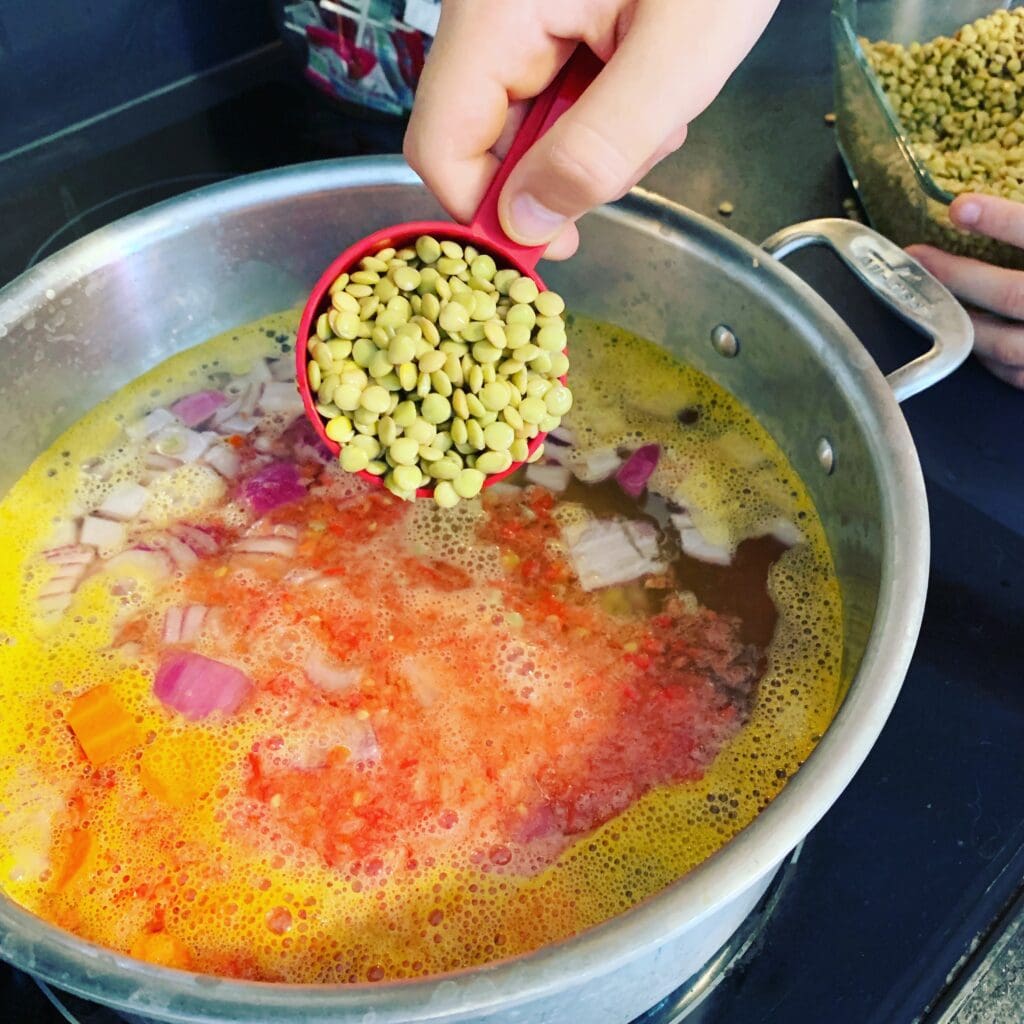
Lentils
Lentils are packed with nutrition and so budget friendly, not to mention versatile! They make a mean soup, veggie burgers, and pasta.
1 cup of lentils has 17 grams of protein and 17 grams of fiber (a serious WOW!) plus folate and other B vitamins, to name just a few.
Because they are not a complete protein, you can combine lentils with a whole grain, like brown rice, to make them complete. This is why you see them served with rice a lot!
Try these lentil recipes:
Lentil Soup is easy to make in a big batch and also a vehicle for other vegetables. (My son found a great recipe in this kids cookbook)
We love lentil veggies burgers in our house – I double (or triple!) the batch and we eat them all week!
Black Beans
Beans have such a mild flavor and can be added to so many different foods.
Black beans pack a nutritional punch with 1/2 cup yielding 8 grams of protein, 7 grams of fiber, plus lots of antioxidants.
Try adding them to smoothies (yes, you can’t even taste them!), brownies!, salads, and your favorite pasta recipe.
Budget tip: Add black beans to a pound of grass fed ground beef to make it go further.
High Protein Fruits and Vegetables
What? Fruits and Vegetables have protein?
Yes!! There are many plants which have a decent amount of protein and can help you and your kids meet your daily protein goal.
And there is a huge bonus – you’ll also be getting a bunch of fiber, vitamins and minerals from eating these veggies, too.
Check out the protein amounts in these vegetables:
- Green Peas – actually a legume! – have 8.6 grams of protein per cup. Peas can be added into pasta dishes, tuna salad and eaten frozen as a snack or blended into a smoothie!
- Spinach has 5.3 grams of protein per cup (cooked). Add chopped spinach to pasta dishes and soups. Eat a huge spinach salad with legumes, nuts, and peas!
- Guava has 5 grams of protein per cup! Wow.
- Artichoke hearts (raw) have 4.8 grams of protein. These are great as part of a salad or just eaten marinated in oil.
- Corn has 4.7 grams of protein per cup. We stay away from corn on our ADHD Diet, but if your kids can tolerate it, it could be a good source of protein. Always eat organic, as corn is one of the most genetically modified foods there is!
- Asparagus has 4.3 grams of protein per cup when it is cooked. I personally love asparagus and am serving it more often to get my kids to love it, too!
- Mushrooms have 4 grams per cup. If your kids like mushrooms, there are so many places to add these in. Enjoy mushrooms raw with dip, cooked in stews, soups, or stir fry them up with some brown rice.
- Brussel sprouts have 4 grams of protein per cup. My kids are not a fan, I keep trying! But I love them cooked up with bacon!
- Kale has 3.5 grams per cup raw, which is pretty great! Add chopped kale into soups, stews, salads, and smoothies.
- Avocado has 3 grams per cup or 4.5 if mahsed. (More mashed fits into a cup!)
- Broccoli has 2.6 grams per cup. Try it raw with a great dip or chopped into tiny peices and added to rice.
- Kiwi has 2 grams of protein per cup!
Protein Powders
Protein powders can be a super easy way to get protein into your kids daily diet. You can blend them in a smoothie and bake them into muffins, cookies and breads.
The key is getting a protein powder free of a bunch of chemicals and sugar. There are so many out there it may be hard to know which ones are best.
Great, clean brands of protein powder:
- Sunwarrior – our personal favorite!!
- Sunfood Chocolate Protein Powder
- Tera’s Whey Protein Powder
- Garden of Life Protein Powder
How do I bake with Protein Powder?
Adding protein powder into your favorite baked goods is easy! Just add a scoop or two to your favorite muffing or cake recipe!
You may have to add a bit more oil or applesauce to combat the dryness and if the protein powder has a strong flavor, cover it up easily with a bit of extra peanut or almond butter.
Also, there are tons of great recipes out there designed especially for protein powders:
These easy, 3 ingredient waffles can be whipped up quickly.
Prep these Vanilla Protein Bites on Sunday and eat all week!
These Protein Pumpkin Bars are full of goodness and so easy to make!
Wow!!! That was a big post – give yourself a pat on the back for making your way through the whole thing! I hope you found a few more High Protein Sources for your ADHD Diet.
Follow me on Instagram for more ideas that will give you some ADHD Parenting relief.




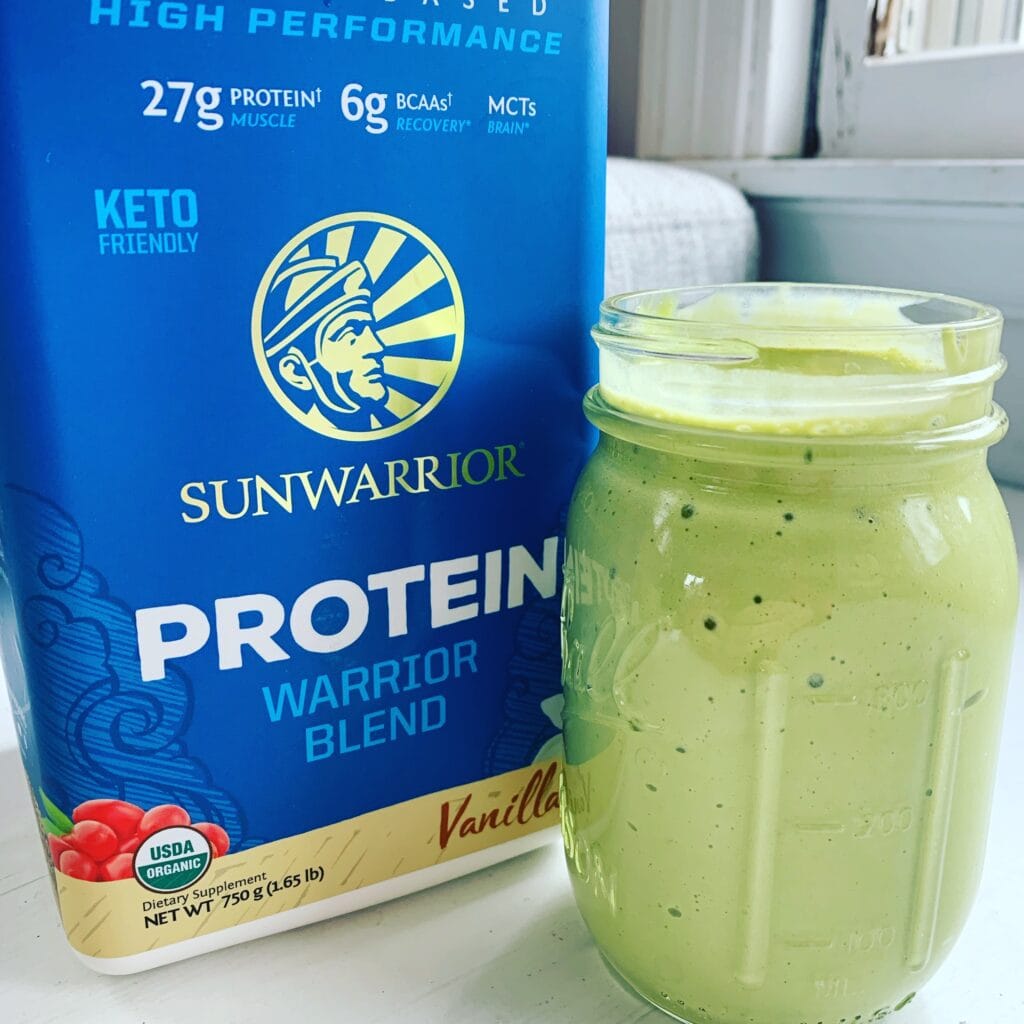




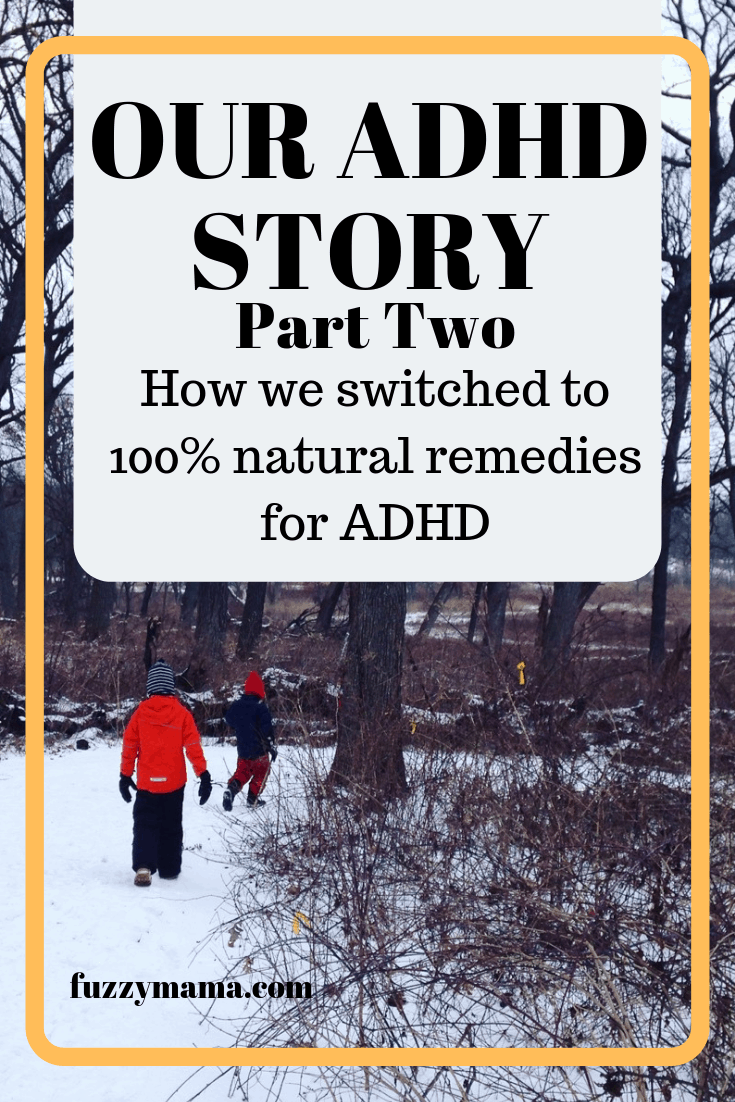
Thank you so much for this post. Lots of great ideas.
You are welcome!! I am always trying to find new things…I just made meatball sandwiches on gluten free hot dog buns with frozen meatballs from Whole Foods heated up in tomato sauce. My boys LOVED them!! The are picky with meat, so I am glad. So, I’ve got a new thing to put into the rotation.
Just a question. I had read somewhere to be careful to not go over the RDA of protein for kids. Specially warning against protein powders and protein bars ect because they can easily become toxic level for the liver/kidneys (?). Are we still just trying to hit a child’s RDA or have you seen different info regarding children’s bodies and protein? Such as i have read a published study saying that adults don’t overload on protein because their bodies can breakdown the amino acids and put them to work in so many areas of the body, eventually even into calories. Would love to hear your thoughts. Many thanks
HI! Great question…I have teenagers so I’m focused on protein. : ) Follow you gut and consult your doctor, too. The RDA numbers for protein seem low to me, but again, I have teenage boys. I focus most on protein at breakfast because I think it sets them up for a great day.